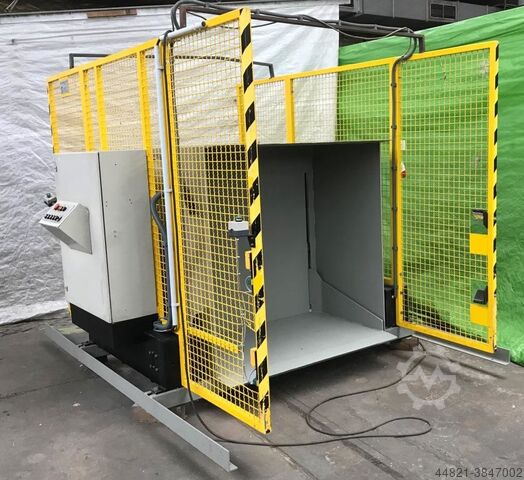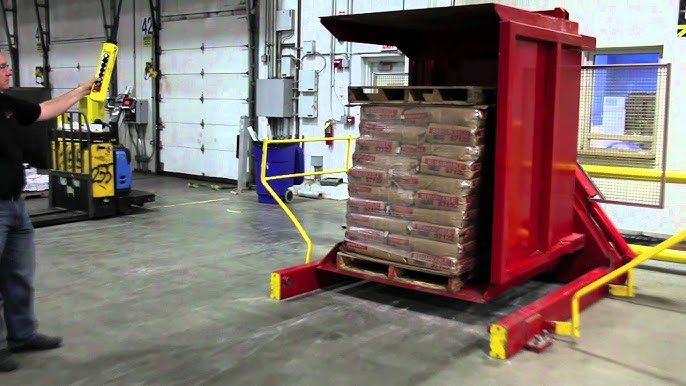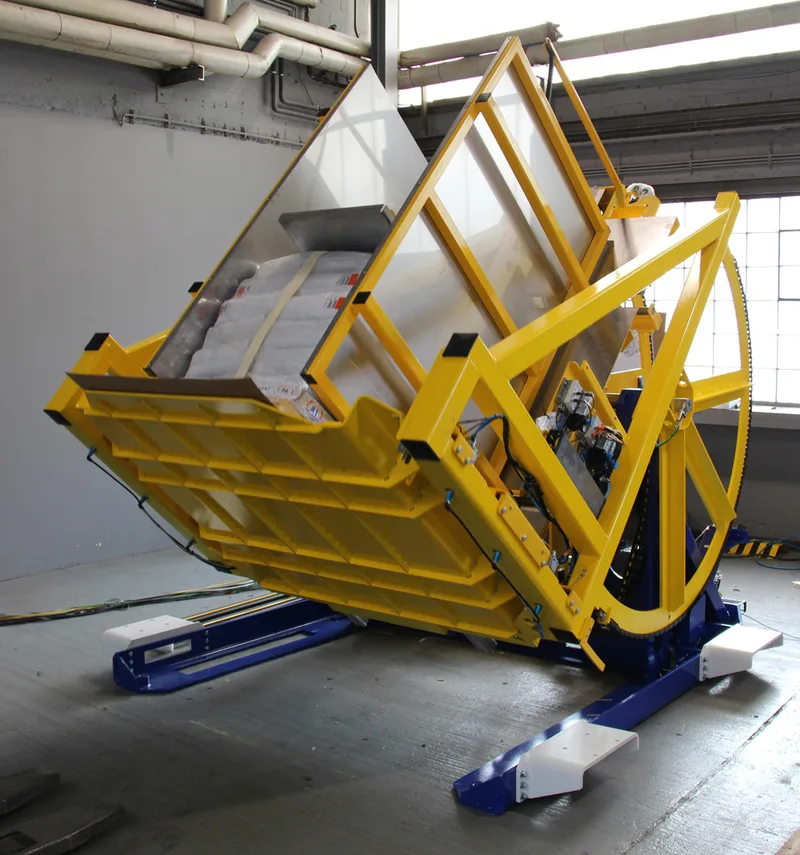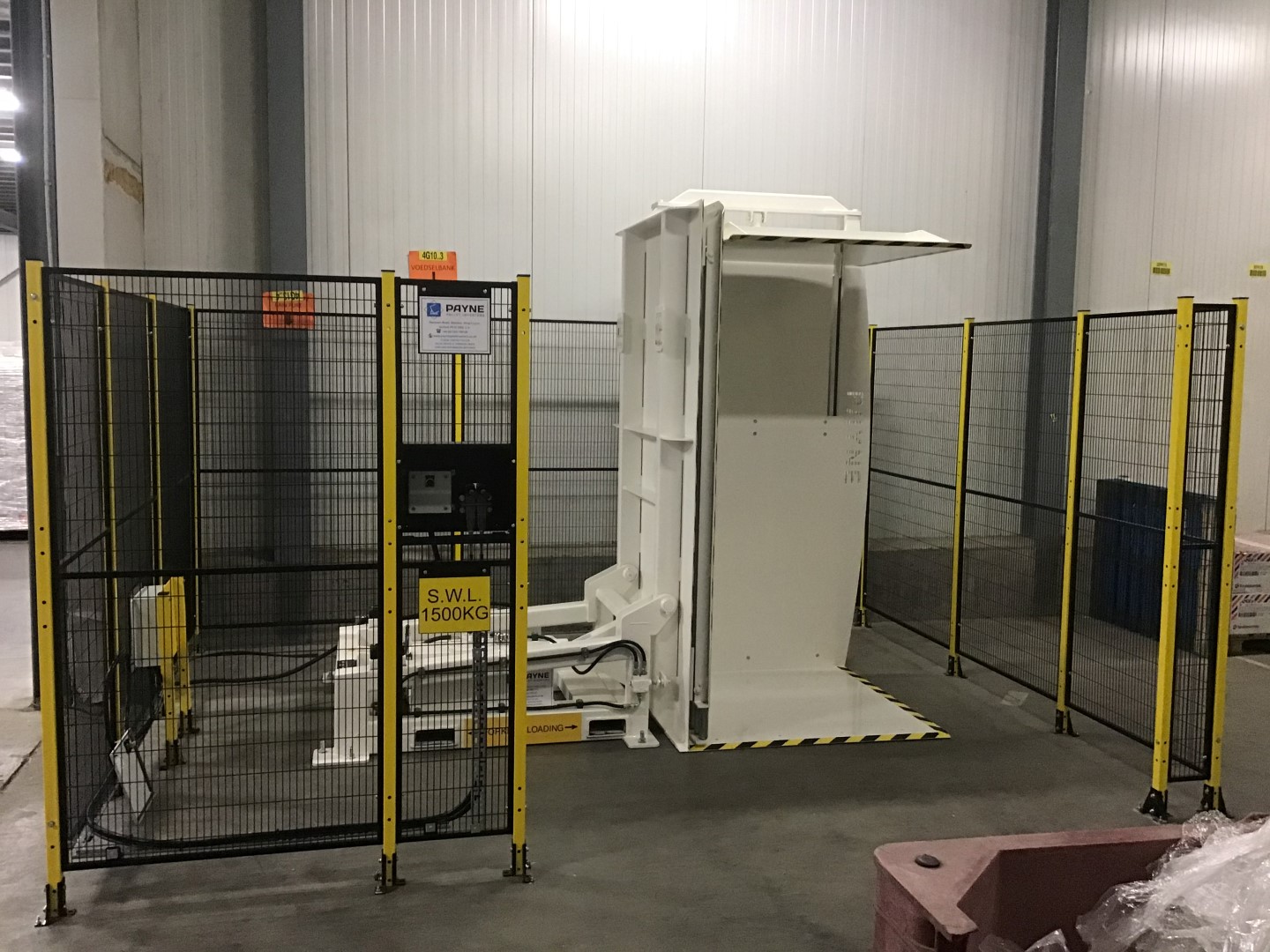Pallet Inverter Safety Tips for Argentina Plants Facing Lower Downtime in Agri-export Processing Plants
In the high-stakes world of Argentina's agri-export sector, every minute counts. Your processing plants are under constant pressure to meet shipping deadlines. A delay of just a few hours can mean the difference between a profitable shipment and a spoiled one. But often, the biggest threat to your schedule isn't the harvest or the shipping lanes; it's a piece of equipment inside your own facility. You've likely experienced the frustration of a sudden production halt, a bottleneck that brings everything to a standstill. It's often caused by a preventable issue with essential machinery, like a pallet inverter, turning a smooth operation into a race against the clock. This downtime isn't just an inconvenience; it's a direct hit to your bottom line and your reputation. What if you could reclaim that lost time and secure your operations by focusing on one of the most overlooked areas: equipment safety?
The most effective way for Argentina's agri-export plants to reduce downtime is to implement a comprehensive pallet inverter safety program. This strategy directly boosts operational reliability. It includes four key pillars: rigorous operator training, ensuring machines have critical safety features like light curtains and interlocked fencing, following a strict preventive maintenance schedule, and planning for seamless integration into your existing workflow. By focusing on safety, you are proactively eliminating the root causes of most unexpected equipment failures and slowdowns.

This might sound simple in theory, but putting it into practice requires a clear plan. I've spent over two decades in the packing machine industry, first as an engineer and now as a factory owner. I've seen firsthand how a focus on safety transforms a plant's efficiency. It's not about adding more rules; it's about building a smarter, more resilient operation. Let's break down the practical steps you can take to make your pallet inverters a source of strength, not stress.
How Can Proper Operator Training Drastically Reduce Pallet Inverter Accidents and Downtime?
You have invested significant capital in a powerful pallet inverter. You expect it to speed up your process of switching pallets for export compliance or to handle damaged goods. But you notice your team seems hesitant when using it. There are small operational errors, near-misses, and minor delays that disrupt the flow. These small problems are warning signs.
These seemingly minor issues can easily grow into a major incident. An operator who isn't fully confident might overload the machine, clamp the load incorrectly, or bypass a safety step to save time. This can lead to a serious worker injury, damage to the inverter, and ruined products. The resulting downtime, investigation, and potential repairs will cost you far more than proactive training ever would.
A structured, hands-on training program is the solution. It is a direct investment in your plant's uptime and your team's well-being. This kind of program turns your operators from simple users into machine experts. They learn to work safely, spot potential problems before they escalate, and handle the equipment with an efficiency that keeps your entire line moving.
Proper operator training drastically cuts down on accidents and downtime. It ensures every user understands the machine's capabilities, its limits, its safety procedures, and how to perform basic troubleshooting. I've seen it time and again in factories I've worked with. Well-trained operators work faster and more safely. They make fewer errors that could damage the machine or the valuable goods you are exporting. They become your first line of defense, identifying strange noises or behaviors that signal a need for maintenance, long before it causes a complete shutdown.

Dive Deeper: Building a Robust Training Framework
A truly effective training program goes beyond just handing an operator the manual. It must be a comprehensive process that builds confidence and competence. In my experience, the best programs are built on two pillars: theoretical knowledge and practical application.
Core Components of an Effective Pallet Inverter Training Program
First, operators need to understand the 'why' behind the 'how'. Classroom or theoretical sessions should cover the machine's purpose in the plant, the principles of its operation (e.g., how the hydraulic clamping and rotation work), and a detailed review of every safety feature. This is where you explain what the light curtain does, why the interlocked gate is critical, and the correct procedure for an emergency stop.
Second is the hands-on practical training. This must be supervised by an experienced trainer. The operator should start with the machine empty, learning the control panel and the sequence of operations. Then, they move on to handling standard, stable loads. Finally, they should be trained on how to handle non-standard or slightly unstable loads, as this is where many problems occur. The goal is to make the safe operating procedure second nature. After the initial training, a supervisor should observe the operator for a period to ensure they are following all protocols correctly.
Fostering a Culture of Safety and Continuous Improvement
Training is not a one-time event. In a busy plant, details can be forgotten. I advise my clients to implement a simple system of regular refresher training, perhaps annually or semi-annually. Also, a quick pre-shift inspection checklist, performed by the operator, reinforces their responsibility and keeps safety top-of-mind. It empowers your team. When operators feel like owners of the equipment they run, they take better care of it. Encourage them to report any abnormalities, no matter how small, without fear of blame. This turns your operators into a network of sensors, constantly monitoring the health of your machinery.
| Aspect | Untrained Operator Risk | Trained Operator Benefit |
|---|---|---|
| Operation | Incorrect sequences, misuse of controls. | Efficient, smooth, and correct operation. |
| Safety | Bypassing safety features, unsafe positioning. | Proactive use of all safety features. |
| Load Handling | Overloading, improper clamping, product damage. | Secure load handling, reduced product loss. |
| Maintenance | Ignoring warning signs (noises, leaks). | Early identification of maintenance needs. |
| Downtime | High risk of user-error-induced breakdowns. | Significantly lower risk of operational downtime. |
What Are the Critical Mechanical and Electrical Safety Features Your Pallet Inverter Must Have?
When you are looking to purchase a pallet inverter, your focus is naturally on performance. You ask about cycle times, load capacity, and the footprint of the machine. These are all important factors. But have you ever made a list of non-negotiable safety features? Choosing a machine based only on speed and power is a significant risk.
A pallet inverter without the right safety systems is a ticking time bomb on your plant floor. Imagine a hydraulic hose failing without a safety valve. The entire load could drop instantly. Or consider an electrical fault that bypasses the clamp pressure sensor, allowing the machine to rotate a load that isn't fully secured. The consequences could be catastrophic, involving serious injury to your staff and complete destruction of your product.
The solution is to know exactly what safety features to demand from a supplier. When you make these features a core part of your procurement specifications, you ensure you are investing in a machine that is not just productive, but fundamentally safe. This protects your people, your product, and the long-term viability of your investment. It shifts the machine from being a potential liability to a reliable asset.
Critical safety features for any modern pallet inverter are non-negotiable. Your machine must have robust perimeter fencing with access gates that are electrically interlocked to the control system. It needs light curtains or safety scanners at the entry and exit points to immediately stop the machine if a person or object enters the danger zone. The emergency stop circuit must be dual-channel and reliable. Mechanically, hydraulic hose burst valves are essential to prevent a sudden collapse in case of a leak. Electrically, a load pressure sensor that confirms the load is clamped securely before rotation begins is a must-have. These systems work together to create layers of protection.

Dive Deeper: A Breakdown of Essential Safeguards
When I design or recommend equipment, I think of safety in two distinct but connected categories: the physical barriers and the intelligent controls. Both are necessary for a truly safe system.
Mechanical Safeguards: The Physical Barriers to Harm
These are the features you can see and touch. They are the first line of defense.
- Perimeter Fencing: This is the most basic requirement. A sturdy fence, typically 2 meters high, creates a clear boundary around the machine's operating area. It prevents accidental entry while the machine is in motion.
- Interlocked Access Gates: Any gate or door in the fence must have an interlock switch. If the gate is opened, the switch sends a signal to the machine's control system, immediately stopping all motion. The machine should not be able to restart until the gate is closed and a reset button is pressed outside the fenced area.
- Hydraulic Hose Burst Valves: These are simple, but vital. It's a valve fitted directly to the hydraulic cylinder. If a hose suddenly breaks, the valve detects the rapid loss of pressure and automatically closes, locking the cylinder in place. This prevents the clamping table or the entire load from crashing down.
Electrical and Sensor-Based Safety: The Brains of the Operation
These are the intelligent systems that monitor the machine and its environment.
- Light Curtains/Safety Scanners: These create an invisible field of light at the machine's opening. If any object, like an operator's hand or a forklift mast, breaks this field, the machine instantly stops. This is crucial for machines that are not fully enclosed and have open loading/unloading points.
- Dual-Channel Emergency Stops (E-stops): Pushing an E-stop button must guarantee a shutdown. A dual-channel system uses redundant wiring and safety relays. This means that even if one part of the circuit fails, the second channel will still ensure the stop command is executed.
- Clamp Pressure Monitoring: The machine must know that it has a secure grip on the pallet load before it begins to turn. A pressure sensor in the hydraulic clamping circuit provides this feedback. The control system should be programmed to not allow rotation until a preset, safe clamping pressure is reached.
| Safety Feature | Function | Risk Mitigated |
|---|---|---|
| Interlocked Fencing | Creates a physical barrier to the danger zone. | Prevents personnel from entering the machine's path of motion. |
| Light Curtains | Creates an invisible safety field at access points. | Protects against reaching into the machine during operation. |
| Hose Burst Valves | Locks hydraulic cylinder if a hose fails. | Prevents sudden load drop due to hydraulic failure. |
| Pressure Sensors | Confirms secure clamping before rotation. | Prevents dropping the load during the inversion cycle. |
Why is a Regular Maintenance Schedule the Secret to Both Safety and Uptime?
In any busy processing plant, the maintenance team is always stretched thin. They run from one emergency to another, putting out fires to keep the main lines running. In this environment, preventive maintenance on equipment that seems to be working fine, like a pallet inverter, often gets delayed or forgotten. It doesn't seem urgent.
This "run-to-fail" approach feels efficient in the short term. You save a few hours of maintenance labor. But this is a dangerous illusion. That approach backfires spectacularly when the pallet inverter breaks down without warning during your peak season. A worn hydraulic hose that would have cost little to replace now bursts, spilling fluid everywhere. A loose electrical connection that a simple inspection would have caught now shorts out the main controller. A minor, preventable repair has become an emergency, halting your entire packing and shipping line. The cost of downtime, cleanup, and emergency repairs skyrockets.
A simple, consistent, and documented maintenance schedule is the solution. It transforms your maintenance activity from a reactive, expensive fire-fight into a proactive, predictable tool. This tool ensures both the safety of your operators and the reliability of your operation. It is one of the most direct ways to boost your plant's overall uptime and profitability.
A regular maintenance schedule is the secret to unlocking both safety and uptime because it allows your team to find and fix small problems before they become catastrophic failures. This is the core principle of reliability. Proactive checks on hydraulic fluid levels and quality, electrical connections, the condition of chains and sprockets, and the function of safety sensors prevent unexpected breakdowns. This discipline ensures your safety features are always working as intended. It also dramatically extends the operational life of your equipment, which maximizes the return on your investment.

Dive Deeper: From Checklist to Culture
Implementing a maintenance schedule is more than just creating a document. It's about creating a routine. I always tell my clients, including those in demanding sectors like steel processing, that the health of their machinery is a direct reflection of their operational discipline. The same applies to agri-export in Argentina.
Building Your Pallet Inverter Maintenance Checklist
A good maintenance plan is broken down by frequency. It creates a rhythm of care for the machine. Here is a simple framework that you can adapt for your specific pallet inverter model.
- Daily (Operator Pre-Shift Check): This takes less than 5 minutes. The operator should do a visual inspection for any leaks, check that all guards are in place, test the E-stop button, and ensure the area is clear of debris.
- Weekly: A maintenance technician should check hydraulic fluid levels, lightly lubricate moving parts like chains, and test the function of the interlocked gates and light curtains. They should also check for any loose bolts or connections.
- Monthly: This involves a more thorough inspection. Check the condition of hydraulic hoses for any cracks or bulges. Inspect electrical cabinets for dust and clean them. Check the tension of drive chains.
- Annually: This is a major service. It should include changing the hydraulic fluid and filter, a comprehensive test of all electrical safety circuits by a qualified technician, and inspection of key structural components and welds.
| Check Item | Frequency | Purpose |
|---|---|---|
| Visual Inspection for Leaks | Daily | Early detection of hydraulic system issues. |
| Test E-stop & Safety Gates | Weekly | Ensures critical safety functions are operational. |
| Check Hydraulic Hoses | Monthly | Prevents hose bursts and catastrophic failures. |
| Change Hydraulic Fluid/Filter | Annually | Maintains system health and prevents component wear. |
The ROI of Prevention
Think about the numbers. The cost of neglect is always higher than the cost of prevention. A planned hydraulic hose replacement might cost $100 in parts and labor. An unplanned hose burst could cost that, plus $500 in lost fluid and cleanup, and thousands of dollars per hour in plant downtime. When you present it this way, a preventive maintenance program is not a cost; it's one of the best investments in profitability you can make.
How Do You Integrate Pallet Inverters Safely into Your Existing Production Line for Seamless Operation?
You've made the decision to invest in a new, efficient pallet inverter. The machine arrives, and the question becomes: where do we put it? It's tempting to just find an open space on the floor and set it up. But this lack of planning can create a whole new set of problems. Placing the inverter in the wrong spot can create a new bottleneck, cause traffic jams with forklifts, and introduce new, unforeseen safety hazards for your team.
This is a common mistake I see. A plant invests in a great piece of technology, but its poor integration makes it a source of frustration. The promised productivity gains never appear. Instead, you see forklifts waiting for access, or workers having to take long, inefficient routes to move pallets. The flow of your entire operation is disrupted, not improved. The new machine fights against your existing process instead of supporting it.
The solution lies in thoughtful planning before the machine is even installed. By analyzing your workflow, planning the physical layout, and using simple automation where possible, you can make the pallet inverter a truly seamless and highly effective part of your production line. It becomes a powerful tool that accelerates your process, rather than an obstacle your team has to work around.
To safely and effectively integrate a pallet inverter, you must first analyze your existing material flow. Identify the most logical point in the process for the inversion to happen. Then, position the machine in a dedicated area with clearly marked entry and exit lanes for forklifts to prevent cross-traffic and collisions. Use floor markings and physical barriers to define the operating zone. For higher volume operations, consider using infeed and outfeed conveyors to automate the process, which reduces manual handling and ensures the inverter complements your production rhythm perfectly.

Dive Deeper: Designing the Flow
Integration is where engineering meets logistics. A machine is only as good as its place in the system. As my company slogan says, we provide a "Total Solution," and that solution always includes thinking about how our machine fits into the client's larger operation.
Workflow Analysis: Mapping the Journey of a Pallet
Before you bolt the inverter to the floor, map out the lifecycle of your pallets. Ask these questions:
- At what stage is the inversion needed? Is it for incoming goods on damaged pallets? Or is it for finished products that need to be switched to export-grade or plastic pallets before container loading? The answer determines where the inverter should be located—near the receiving docks or near the shipping area.
- What is the volume? A plant that inverts 10 pallets a day has very different needs than one that inverts 100 pallets a day. For low volumes, a stand-alone area is fine. For high volumes, a pass-through, conveyor-fed system is far more efficient.
- What is the traffic pattern? Watch how your forklifts currently move. The goal is to place the inverter in a location that minimizes travel distance and avoids creating intersections where forklifts might compete for space. The flow should be linear: In -> Invert -> Out.
Physical Layout and Automation
Once you know the best location, consider the physical setup.
- Space Requirements: Don't just account for the machine's footprint. You need ample, clearly marked space for a forklift to approach, align, and back away safely without maneuvering in a tight area. You also need a "staging area" for pallets waiting to be inverted and for the empty pallets coming out.
- Automation for Efficiency and Safety: For any plant handling significant volume, conveyors are a game-changer. An infeed conveyor allows a forklift driver to drop a pallet and leave immediately, without waiting for the cycle to finish. The machine automatically takes the pallet. An outfeed conveyor then presents the finished load for pickup. This decouples the forklift's work from the machine's cycle time, dramatically improving efficiency and reducing the amount of time a forklift needs to be near the machine. This automation also inherently improves safety by minimizing direct interaction between the forklift and the inverter.
| Integration Factor | Poor Integration | Smart Integration |
|---|---|---|
| Workflow | Creates a new bottleneck, disrupts pallet flow. | Placed at a logical point, linear flow (In/Out). |
| Safety | Forklift traffic conflicts, undefined work area. | Dedicated zone, clear markings, one-way traffic. |
| Efficiency | Forklift waits for machine cycle, double handling. | Staging areas, use of conveyors to buffer flow. |
A Final Insight from My Journey
I started my career on the factory floor. I learned about machines with my own hands. Later, when I built my own factory, I had to manage budgets, production targets, and the well-being of my team. I can tell you from personal experience, especially from my work with heavy industries like steel, that safety and uptime are not separate goals. They are two sides of the same coin.
In Argentina's agri-export business, your product is perishable and your deadlines are absolute. You cannot afford downtime. Many see safety measures—the guards, the training, the maintenance schedules—as a cost or a compliance requirement. This is the wrong way to look at it. I learned, sometimes the hard way, that every dollar and every hour you invest in proactive safety and maintenance pays you back tenfold. It pays you back in breakdowns that never happen. It pays you back in accidents that are prevented. And most importantly, it pays you back in the steady, predictable, and reliable output of your plant.
When you are looking for equipment, don't just look for a supplier who sells you a machine. Look for a partner who understands your operation. A partner who has faced the same pressures and knows that a machine is only valuable when it is running safely and reliably. This focus is the true foundation of a profitable and resilient business.
Conclusion
Prioritizing pallet inverter safety through training, proper features, maintenance, and integration is the most direct path to reducing downtime and securing your plant's profitability in the demanding export market.




